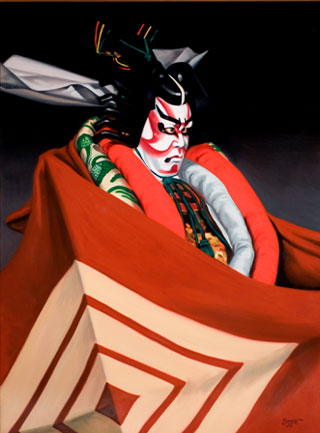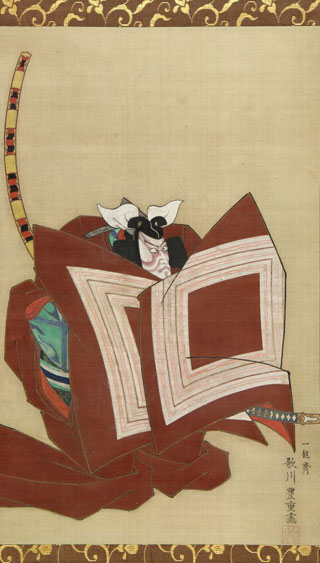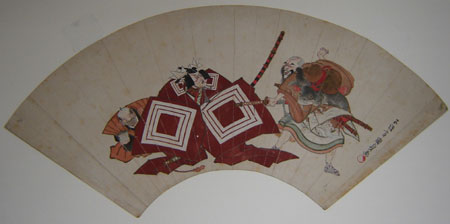
『暫』の魅力(English)
『暫』の魅力とは何でしょうか。
今では歌舞伎の代表作であり、最も有名な作品のひとつですが、なぜそれほどまでのインパクトがあるのでしょうか。江戸時代には毎年興行され、今日においては、西洋人が観たい演目もやはり『暫』なのです。
私たちを魅了するのは、古来の勧善懲悪といった極めて単純な『暫』のあらすじでは、おそらくないと思います。悪人が、捕虜として捕まった善人たちの首を落とすように家来に命じる。善人たちが殺されてしまうまさにそのとき、間一髪で主人公の若い勇者が登場し、悪人とその家来を脅すことで、善人たちは難を逃れることができる。悪人は、去っていく勇者をなすすべなくただ見送るしかない。これはまさに、マンガの「ザ・シンプソンズ」でいう「にらみ殺してやる!(the frowning of a lifetime)」という状況です。
とりわけ面白いストーリーだとは言えませんが、歌舞伎で一番重要なのは演目の筋ではありません。『暫』のみどころは、主人公の登場場面に他ならないでしょう。この主人公の名は、過去に何度か変わっていますが、鎌倉権五郎景政(※編集注:この原稿ではこの名称で統一します)。この油絵は、スコットランド人の画家、ポール・ビニーによる、鎌倉権五郎役の九代目松本幸四郎さんです。

Shibaraku - Matsumoto Koshiro IX by Paul Binnie.Oil on canvas. Collection of Ronald Cavaye.
西洋人にとって(日本人にとってもそうかもしれませんが)、鎌倉権五郎の風貌には形容しがたい迫力があります。何か塗ってある顔や、車輪の輻のようにセットされた髪形。そしてあの羽のような大きい紙は一体何でしょうか? これは実は力を象徴する「力紙」ですね。さらに、あの素晴らしい衣装の袖。そこで、ビニー画と歌川豊重画(1820-25年頃)を比べてみてください。

Shibaraku - Ichikawa Danjuro VII. Painting by Utagawa Toyoshige, ca. 1820-25 Collection of Paul Griffith.
これは七代目市川團十郎さん(1791-1859年)ですが、衣装と化粧は現在のものとほぼ変わりません。この浮世絵には大太刀も描かれています。鎌倉権五郎がこの大太刀ひと振りで十人の首を切る場面は、この演目の中でもっとも面白いところです。
外国人にとって、『暫』の純真かつ喜劇的な面は、歌舞伎の意外な要素なのではないでしょうか。歌舞伎は厳粛なものが多く(『忠臣蔵』の九段目など)、笑いを誘う場面は珍しいほうです。例えば、あの有名な腹出し。太っていてこっけいな腹出しと男なまずが彼らのひどく恐れている鎌倉権五郎を追い払おうとしている姿が、歌川国貞の扇面に描かれています。こちらは、(少し太り気味に描かれてしまっていますが)若い頃の七代目市川團十郎さんと、おそらく二代目坂東善次さんの演じた男なまずです。市川團十郎さんの後ろには後見が座っており、鎌倉権五郎の「つらね」の後に歌舞伎俳優が飲むお茶を持っています。

Shibaraku - Ichikawa Danjuro VII. Fan painting by Utagawa Kunisada, ca. 1809-12 Collection of Paul Griffith.
どの西洋人にも理解出来ないのは、『暫』の主人公がまだ青年であることです。これは鎌倉権五郎の前髪が剃られていない(成人するときにする儀式)ことからわかります。今の若い日本人はこれを知っているでしょうか。このような、些細でありながら重要な点を理解するのに、イヤホンガイドは欠かせませんね。
また、『暫』が江戸時代に毎年興行されていたということは、この演目が昔の人たちにとっても非常に面白いものだったということもあるのでしょう。150年たった今では、歌舞伎の代表作として定着しているため、当時の新鮮さは失われてしまっているのかもしれませんが、舞台と数多い衣装の美しさには、相変わらず感動するものがあります。現在においても、鎌倉権五郎を演じる歌舞伎俳優からは1809年当時の感動が想像できます。
最後にもうひとつ。『暫』はよく"Wait a Moment!"(ちょっと待った!)と英語に訳されますが、これはもともと「し・ば・ら・く」(4音)に合わせて"Wait-a-mo-ment"(4音)としたことからきています。それはそれでいいのですが、英語で言う"Wait a moment"には弱い響きがあり、むしろ丁寧な表現になるため、『暫』には合いません。「しばらく」は命令調であり、お願いではありません。ですから、私は"Stop!"または"Wait!"(待て!)といった、もっと強い表現がふさわしいと思います。そもそも、あんな衣装を身に着けた人物が丁寧な言い方をするわけがないですからね。
■ロナルド・カヴァイエ
コンサートピアニストとしてロンドン、ハノーバー、ブダペストで学んだ後、1979~1986年、武蔵野音大にて教鞭をとる。現在はロンドンに住み、年に数回、コンサート、授業、講演などで来日している。
最初に歌舞伎を見たのは1979年。1982年には最初の英語イヤホンガイドの解説者になる。音楽教育と歌舞伎に関する著書があり、1993年に「Kabuki - A Pocket Guide」(Charles E. Tuttle)を日米で、2004年には「A Guide to the Japanese Stage」(講談社インターナショナル)をポール・グリフィス、扇田 昭彦との共著として出版した。
2002年には、鈴ヶ森を「Kabuki Plays on Stage Vol. III - Darkness and Desire」(University of Hawai'i Press)へと翻訳し、昨年は松竹とNHKが制作する歌舞伎DVDの新シリーズの解説、字幕制作をおこなった。
This play has almost become a symbol of Kabuki and it's certainly one of the most famous plays in the repertoire. But why does it create such an impact? It was performed year after year during the Edo Period and today it's also the play which many Westerners most want to see.
It can't be the plot that fascinates us - a simple story about the age-old conflict between good and evil. A villain has captured a group of people and orders them to be beheaded. Just as they are about to be killed, a young hero enters, threatens the villain and frightens his retainers so much that the people are set free. Then, with nothing more than what in The Simpsons is called, "the frowning of a lifetime," the hero goes off, leaving the villain helplessly looking on.
This is not a very inspiring plot but, in Kabuki, the story is not necessarily the most important thing. I don't think that there can be any doubt that one of the play's main attractions is the appearance of the principal character. Today he is usually called Kamakura Gongoro Kagemasa but he had many other names over the years. Here is a painting of Matsumoto Koshiro IX in the role by the contemporary Scottish artist, Paul Binnie.

Shibaraku - Matsumoto Koshiro IX by Paul Binnie.Oil on canvas. Collection of Ronald Cavaye.
For Westerners (and, I guess, Japanese too) his appearance is incredible. The painted face... the hair set like the spokes of a wheel... What are those huge wings of paper? (They are called chikara gami and symbolise strength.) And above all, those fantastic sleeves! Compare the Binnie painting with one made by Utagawa Toyoshige in about 1820-25.

Shibaraku - Ichikawa Danjuro VII. Painting by Utagawa Toyoshige, ca. 1820-25 Collection of Paul Griffith.
This is Danjuro VII (1791-1859) and his costume and makeup are almost identical to the ones we see today. This painting also shows us his great sword - the sword which gives the play its best comic moment when the hero cuts off the heads of about ten men with one blow!
I suspect that the child-like, comic qualities found in Shibaraku are surprising to most foreigners. There is a lot of very serious Kabuki (think of Act IX of Chushingura!) and opportunities to laugh aren't common. But in Shibaraku we have the famous haradashi - the "stomach thrusters," for example. Fat and stupid, they are petrified of Gongoro, as is the comical Namazu Bozu, the "catfish priest" called Shinsai who tries to get the hero to leave and who is depicted in this fan painting by Utagawa Kunisada. Here we see a younger Danjuro VII (with a rather chubby face!) and Shinsai, possibly played by Bando Zenji. Behind Danjuro sits a koken stage assistant who is holding the cup of tea which, traditionally, the actor drinks from after his introductory speech - the tsurane.

Shibaraku - Ichikawa Danjuro VII. Fan painting by Utagawa Kunisada, ca. 1809-12 Collection of Paul Griffith.
One thing that no Westerners appreciate is that the hero is only a boy. We can tell this by the fact that he has yet to have his forelock of hair shaven - a ceremony which would have taken place by about the age of twenty. I wonder how many young Japanese visitors to Kabuki notice that? It is for such subtle but important points as these that the Japanese and English earphone guide explanations are essential.
As Shibaraku was performed year after year, the Edo Period audiences must have found it really exciting. Much of that freshness is lost today as, over the last 150 years or so, the play settled into its present form and became less of an annual excitement and more of a "classic". But the set and the large number of actors - some dressed in the most fantastic costumes - can still thrill us. And an exciting performance by the leading actor can still give as an idea of how those fortunate people in the audience felt in 1809!
And one more thing: Shibaraku is usually translated as "Wait a Moment! This was originally chosen because of the syllable count - shi-ba-ra-ku (four syllables), the same as wait-a-mo-ment. While that does work, the phrase "wait a moment" is rather weak and polite in English and that doesn't suit the play at all. "Shibaraku" is an order, not a request! So I prefer either "Stop!" or perhaps "Wait!" which are strong commands. After all, any character wearing that costume is hardly going to be polite!
Ronald Cavaye
Ronald Cavaye is a concert pianist who studied in London, Hannover and Budapest. He was professor of piano at the Musashino Academy of Music in Tokyo between 1979-1986. Now living in London, he returns to Japan several times a year for concerts, teaching and lectures.
Ronald Cavaye first saw a Kabuki play in 1979 and in 1982 became one of the first narrators (kaisetsusha) of the English Earphone Guide. He has written books on music education and Kabuki - "Kabuki - A Pocket Guide": Charles E. Tuttle, USA and Japan, 1993 and "A Guide to the Japanese Stage": (with Paul Griffith and Akihiko Senda), Kodansha International, Japan, 2004.
He translated Suzugamori for "Kabuki Plays on Stage Vol. III - Darkness and Desire": University of Hawai'i Press, 2002 and for the past year has been working on the commentaries and subtitles of the new series of Kabuki DVDs being produced by Shochiku and NHK.
